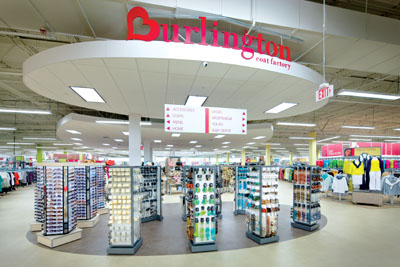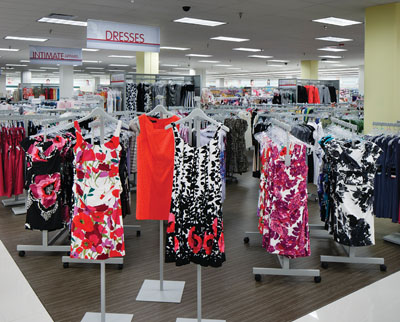Burlington Coat Factory maintains an ambitious plan to refresh and renovate.
With more than 460 stores in 44 states and Puerto Rico, Burlington Coat Factory has long had a significant presence in the off-price retail store niche. But its ambitions don’t end there. The company is planning 20-23 new stores, including relocations, during 2011. Its maintenance team will also undergo change by maintaining new facilities from the start and implementing green initiatives.
 The top priority for Burlington is updating its older facilities to match the upgraded quality of the newer stores. This refresh program includes changing carpeting, painting and updating restrooms. “We’re going in and updating the things that have the most need,” says Kelly Radford, Burlington’s vice president of facilities. “It depends on what the original finishes were for that store and how well they have held up over time.”
The top priority for Burlington is updating its older facilities to match the upgraded quality of the newer stores. This refresh program includes changing carpeting, painting and updating restrooms. “We’re going in and updating the things that have the most need,” says Kelly Radford, Burlington’s vice president of facilities. “It depends on what the original finishes were for that store and how well they have held up over time.”
One of the main factors affecting the condition of stores is weather. Moisture has a tremendous impact on coastline stores; similarly, HVAC units go through more wear and tear in extreme conditions.
Along with the impact of weather elements, the traffic volume of a store is also considered when determining which stores need to move to the top of the refresh priority list. Higher traffic volume naturally means updates need to happen sooner.
In addition to refreshing existing stores, Burlington Coat Factory is changing its maintenance program to one that is territory-based. Currently, the company’s stores are divided into five territories of 90 to 100 stores each. Each territory will eventually have an assigned facilities coordinator with whom the regional vice presidents and individual store managers will communicate. Radford says that the stores will greatly benefit from having one point of contact.
While the territory coordinators will manage their respective territories, the new plan allows program specialists to oversee the overall program. Having specialists manage the individual programs — such as preventative and planned maintenance programs — allows territory directors to devote more time to effective execution of maintenance calls.
 “We have a web-based work order program through which the stores submit service requests,” says Radford. “Requests are received by the coordinator for that territory who then directs them to the preferred vendor. And provided everything was completed correctly, the vendor can invoice through the system electronically, saving paper.”
“We have a web-based work order program through which the stores submit service requests,” says Radford. “Requests are received by the coordinator for that territory who then directs them to the preferred vendor. And provided everything was completed correctly, the vendor can invoice through the system electronically, saving paper.”
Emergency service calls will be handled in a similar manner under the restructuring program. Due to the 24-hour response time on emergencies, in some cases the call will go directly to the vendor. If the emergency revolves around the store losing power, Burlington has set up a call center that will delegate the call internally to the correct person in that territory.
The way Burlington Coat Factory ultimately decides on a vendor is also influenced by their desire to maintain facilities from the very beginning. As soon as a store opens, the cycle of maintenance visits and upkeep begins. “Our preference is that any company we deal with has an account manager who’s going to follow up and report back to us on any issues before they grow,” says Radford.
Because deferring maintenance in the short run will only cost more money in the future, Burlington has implemented a painting maintenance program for some stores. Under this program, stores receive touch up painting every quarter. This touch-up program extends the time frame in which the entire store will eventually have to be repainted.
“Do not cut your preventive maintenance visits, because while it’s a ‘win’ right now, it’s not going to be in the future,” advises Radford. “You don’t have to stop maintaining the store if you come up with a very creative plan and partner with your vendors, because they’re out there.”
In some areas Burlington chooses a national company, while preferring local vendors in other trades. One area where vendors and companies can both benefit includes a focus on energy-efficient standards. “The biggest thing we look for is a fit. If a vendor finds a more efficient way of doing things and can cut our cost to deliver that service, then they should take the initiative to let us know without having to ask,” says Radford. “I find that green initiatives are one of the things they will come forward with pretty consistently.”
While implementing green initiatives helps the planet, it also helps companies because they know they will see a return on investment. Burlington Coat Factory has an energy department that concentrates specifically on investing and researching sustainable measures. The company has been retrofitting lighting to more efficient models and many stores are equipped with EMS systems that control the lighting and temperatures — ultimately conserving energy. Future initiatives include recycling in its distribution centers, as well as an analysis of floor finishes in the desire to decrease the amount of chemical cleanings in stores.
Saving money is one area that requires constant analysis from the beginning, which is one of the reasons Burlington decided to adopt a new maintenance program. “All the issues that you’re going to deal with are directly related to the plan you put in place at the birth of the facility,” says Radford. “It’s really important for us to always keep in mind: how do we design and maintain a store so that we can continue to deliver that value.”
For Burlington Coat Factory, it all boils down to finding the perfect fit for the company and figuring out what works and what doesn’t in a timely manner. Revamping its entire maintenance program allows Burlington to focus more emphasis on all stores – older stores that have undergone renovation as well as the new stores. The new maintenance program also allows for investing in green initiatives in order to reap long term benefits.
